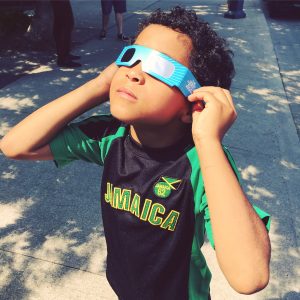A Few Tips for When Your Child is Getting Glasses for the First Time

I started wearing glasses in grade 2. I hated them, mainly because I grew up during the era of oversized, not-at-all-stylish “Coke bottle” frames. My elementary school pictures are, in a word, hideous. I got contact lenses as soon as I could, and although I wear glasses around home sometimes, I still don’t enjoy them.
Not surprisingly, my son got his first prescription for glasses at age 5. I desperately wanted the transition to be a positive one for him, but how was I going to pull that off?
As I would soon learn, the most important thing is to find an optician that you connect with. Luckily, we found Zully Kasmani, the managing optician at our local Walmart Vision Centre (and a father of three).
From the moment we walked in – a mom with a deep-rooted dislike of glasses and a shy, curious son – Zully put us at ease. He allowed us to browse through the frames at our own pace. He introduced himself to my son and spoke to him warmly. Things were looking up.
Here are some first-timer tips that we learned in the process:
Do your research
Your child’s first pair of glasses may not cost you anything. Some provinces (including Ontario, Alberta and New Brunswick) offer free glasses for kindergarten-aged children. Shop around at local retailers for seasonal sales or special pricing. For example, Loblaw Optical offers a “Kids See Free” program for children ages 4 to 10.
Choose the right frames
Your child needs a practical pair of glasses that can handle her busy, active day. As with adult eyewear, there are two main options: plastic frames without nose pads and metal frames with nose pads. According to Zully, “Plastic frames are generally more durable and slightly safer than metal, as they do not have any nose pads which could cause injury on impact.” When your child is trying on frames, he suggests checking the following:
A plastic frame should rest comfortably on the nose without a gap. Since the bridge has a fixed size, it should fit perfectly from the beginning to prevent the frame from slipping down.
If considering a metal frame: The nose pads can be adjusted for a custom fit.
The arms of the glasses should be adjusted to the appropriate length. There should be no pressure or discomfort at the ear.
For optimal vision: The child’s eyes should be in the centre of the frame or slightly above the mid-line.
When it comes to styles, kids have a wide variety of colourful and stylish frames to choose from, featuring well-known characters like SpongeBob SquarePants and Hello Kitty. While parents should oversee the process, Zully’s advice is to let the child have some input, too. “If the child ends up with a frame that he dislikes or is uncomfortable with, it is likely that he will not wear the glasses, which will defeat the purpose of getting them,” he says.
I can certainly vouch for this. Since there was a 2-for-1 promotion, I selected a minimalist metal frame and gave my son free rein to choose the second pair himself. He settled on a pair of bold Teenage Mutant Ninja Turtle plastic frames that he loves dearly and has worn happily from day one. Would I have chosen them? No. Am I glad I let him get the ones he really wanted? Yes.
Take care of the eyewear
You’ll want to teach your glasses rookie not to touch the lenses, but inevitably, they will become smudged with fingerprints and grime. Zully recommends purchasing an eyeglass cleaner spray and doing a daily morning wipe-down. “Spray the cleaner on the front and back of each lens and wipe the liquid back and forth on the lens with your clean fingertips,” he instructs. “Then, gently mop up the excess cleaner with a soft cleaning cloth.”
Kids won’t instinctively have a “handle with care” approach to owning glasses, but try to build good habits from the start. For example, they should use two hands when putting on or taking off the glasses, to avoid overextending the hinges. It’s wise to establish a storage routine so the glasses don’t end up in random and unexpected places. For very young kids, a verbal reminder like “on your face or in the case” can be helpful.
Despite your best efforts, the glasses will probably face some wear and tear. This is another reason to choose a pleasant and friendly optician, since you and your child may be visiting him or her regularly. Ask proactively about the process of getting repairs and adjustments, and find out if the frames and lenses are covered by a warranty.
Have an upbeat attitude
For me, this was a “fake it ‘til you make it” situation. I wasn’t excited about the glasses, but I knew my son would follow my lead, so I pretended that I was. As it turned out, the experience was so positive and my son was so delighted that my happiness actually became real. I never thought I’d see the day.















Hi there, thank you so much for sharing ♥️ In two days my 4yo daughter is getting her first time glasses and I’m sad because I know this means probably family jokes or school jokes, but I’ll have best attitude 😍 thx again!